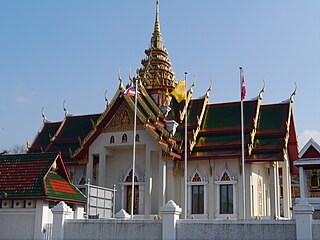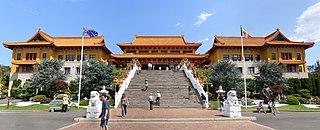
Sangha is a Pali word used in many Indian languages, including Sanskrit which means "association", "assembly", "company" or "community"; in these languages, sangha is frequently used as a surname. In a political context, it was historically used to denote a governing assembly in a republic or a kingdom, and for a long time, it has been used by religious associations, including Buddhists, Jains and Sikhs. Given this history, some Buddhists have stated that the tradition of the sangha represents humanity's oldest surviving democratic institution.
Buddhism in the West broadly encompasses the knowledge and practice of Buddhism outside of Asia in the Western world. Occasional intersections between Western civilization and the Buddhist world have been occurring for thousands of years. The first Westerners to become Buddhists were Greeks who settled in Bactria and India during the Hellenistic period. They became influential figures during the reigns of the Indo-Greek kings, whose patronage of Buddhism led to the emergence of Greco-Buddhism and Greco-Buddhist art. There was little contact between the Western and Buddhist cultures during most of the Middle Ages but the early modern rise of global trade and mercantilism, improved navigation technology and the European colonization of Asian Buddhist countries led to increased knowledge of Buddhism among Westerners. This increased contact led to various responses from Buddhists and Westerners throughout the modern era. These include religious proselytism, religious polemics and debates, Buddhist modernism, Western convert Buddhists and the rise of Buddhist studies in Western academia. During the 20th century, there was a growth in Western Buddhism due to various factors such as immigration, globalization, the decline of Christianity and increased interest among Westerners. The various schools of Buddhism are now established in all major Western countries making up a small minority in the United States, Europe, Australia and New Zealand.

The schools of Buddhism are the various institutional and doctrinal divisions of Buddhism which are the teachings off buddhist texts. The schools of Buddhism have existed from ancient times up to the present. The classification and nature of various doctrinal, philosophical or cultural facets of the schools of Buddhism is vague and has been interpreted in many different ways, often due to the sheer number of different sects, subsects, movements, etc. that have made up or currently make up the whole of Buddhist traditions. The sectarian and conceptual divisions of Buddhist thought are part of the modern framework of Buddhist studies, as well as comparative religion in Asia. Some factors in Buddhism appear to be consistent, such as the afterlife.

Theravada Buddhism is the largest state religion headquartered in Sri Lanka, practiced by 70.2% of the population as of 2012. Practitioners of Sri Lankan Buddhism can be found amongst the majority Sinhalese population as well as among the minority ethnic groups. Sri Lankan Buddhists share many similarities with some Southeast Asian Buddhists, specifically Myanmar Buddhists and Thai Buddhists due to traditional and cultural exchange. Sri Lanka is one of only five polities in the world where Theravada Buddhism is the predominant religion, and others are Thailand, Cambodia, Laos and Myanmar.

Buddhism is the largest religion in Singapore, practiced by approximately 31.1% of the population as of 2020. As per the census, out of 3,459,093 Singaporeans polled, 1,074,159 of them identified themselves as Buddhists.

The term American Buddhism can be used to describe all Buddhist groups within the United States, including Asian-American Buddhists born into the faith, who comprise the largest percentage of Buddhists in the country.

With nearly 250,000 Buddhists, Brazil is home to the third-largest Buddhist population in the Americas, after the United States and Canada. Buddhism in Brazil consists of practitioners from various Buddhist traditions and schools. A number of Buddhist organisations and groups are also active in Brazil, with nearly 150 temples spread across the states.

Buddhism in Thailand is largely of the Theravada school, which is followed by roughly 93.4 percent of the population. Thailand has the second largest Buddhist population in the world, after China, with approximately 64 million Buddhists. Buddhism in Thailand has also become integrated with folk religion (Bon), Hinduism from millennia of Indian influence, and Chinese religions from the large Thai Chinese population. Buddhist temples in Thailand are characterized by tall golden stupas, and the Buddhist architecture of Thailand is similar to that in other Southeast Asian countries, particularly Cambodia and Laos, with which Thailand shares cultural and historical heritages. Thai Buddhism also shares many similarities with Sri Lankan Buddhism. Thailand, Cambodia, Myanmar, Sri Lanka and Laos are countries with Theravada Buddhist majorities.
The European Buddhist Union (EBU) is the umbrella organization of Buddhist communities and national Buddhist unions in Europe. The EBU is open to all schools and traditions of Buddhism in Europe wishing to unite on the basis of Buddhist teachings and work together in spiritual friendship and respect for diversity. According to the 'EBU Statement of Mission and Vision' the aims are to facilitate international exchange and promote spiritual friendship amongst European Buddhists, to support social action and ideas motivated by Buddhist values, and to amplify the voice of Buddhism in Europe and worldwide.

Buddhism is a minority religion in Switzerland. According to the 2000 census, 21,305 Swiss residents self-identified as Buddhists. About a third of them were born in Thailand.

Buddhism is the third largest religion in France, after Christianity and Islam.

In Australia, Buddhism is a minority religion. According to the 2021 census, 0.2 percent of the total population or 30,474 of Australia identified as Buddhist. It was also the fastest-growing religion by percentage, having increased its number of adherents by 79 percent between the 1996 and 2001 censuses. The highest percentage of Buddhists in Australia is present in Christmas Island, where Buddhists constitute 18.1% of the total population according to the 2016 Census. Buddhism is the fourth largest religion in the country after Christianity, Islam and Hinduism.

Buddhism is an ancient Indian religion, which arose in and around the ancient Kingdom of Magadha. It is based on the teachings of Gautama Buddha, who lived in the 6th or 5th century BCE and was deemed a "Buddha". However, Buddhist doctrine holds that there were other Buddhas before him. Buddhism spread outside of Magadha starting in the Buddha's lifetime.

Buddhism is one of the major religions of Taiwan. Taiwanese people predominantly practice Mahayana Buddhism, Confucian principles, Taoist tradition and local practices. Roles for religious specialists from both Buddhist and Taoist traditions exist on special occasions such as for childbirth and funerals. Of these, a smaller number identify more specifically with Chinese Buddhist teachings and institutions, without necessarily eschewing practices from other Asian traditions. Around 35% of the population believes in Buddhism.

Buddhism in the United Kingdom is the fifth-largest religious group in the United Kingdom. The 2021 United Kingdom census recorded just under 290,000 Buddhists, or about 0.4% of the total population, with the largest number of Buddhists residing in Greater London and South East England. According to a Buddhist organisation, the growth of Buddhism in the United Kingdom is mainly a result of conversions.

Buddhism in Scotland is a relatively recent phenomenon. In Scotland, Buddhists represented about 0.3% of the population (15,501) in the 2022 census.
Buddhism in Wales is followed by 0.3% of the Welsh population, according to the 2021 Census. Buddhism has a relatively short history, having only really established a presence in the country in the 20th Century. 10,075 people in Wales declared themselves Buddhist in the 2021 Census, representing a number of Buddhist traditions.

Dhammalok Mahasthavir was a Nepalese Buddhist monk who worked to revive Theravada Buddhism in Nepal in the 1930s and 1940s. For this act, he was expelled from the country by the tyrannical Rana regime.

Ratmalane Sri Dharmaloka Thera was a scholar Buddhist monk who lived in the 19th century in Sri Lanka. An educationist and revivalist of Sri Lankan Buddhism, he was reputed for his knowledge of Pali, Sanskrit and Buddhist Philosophy. Ratmalane Sri Dharmaloka Thera was the founder of Vidyalankara Pirivena, Peliyagoda, which was granted the University status later by the Sri Lankan government in 1959, and presently known as University of Kelaniya. Sri Dharmaloka College in Kelaniya, Sri Lanka is named after him.
Buddhism is New Zealand's third-largest religion after Christianity and Hinduism standing at 1.5% of the population of New Zealand. Buddhism originates in Asia and was introduced to New Zealand by immigrants from East Asia.















